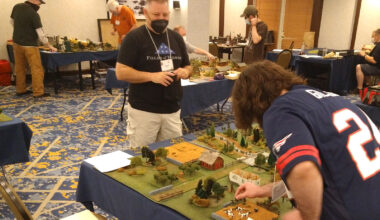This time on Forces of Fame, I’ve had enough of being laughed at for my obsession with armour, so I’m staging a revolt! I’ll be taking a look at the M18 Hellcat, America’s most successful tank destroyer (TD) of the Second World War, and there’s nothing my editor can do to stop me (there is, but only if I so choose -ed.)!
The M18 was conceived to provide the US Army’s Tank Destroyer Force with a highly-mobile and versatile TD, capable of engaging enemy armour with its powerful 76mm gun and then rapidly redeploying. A completely new design, as opposed to the earlier M10 which was based on the proven M4 Sherman hull, the M18 (also known as the ‘Hellcat’) proved a valuable asset to US forces when it first saw combat in Spring 1944, particularly in Europe as the Allies pushed through France and into Germany. 2,507 examples were produced between Summer 1943 and Autumn 1944.
The American TD concept emphasised mobility and speed above all things. The theory behind this was to oppose German Blitzkrieg tactics by meeting enemy attacks quickly with concentrated force, rather than attempting to defend entire areas with thinly-stretched anti-tank guns. While the overall execution of this concept was flawed (and swiftly abandoned following the end of the war), the core tactical doctrine of ‘fire and withdraw’ was sound, and the vehicles produced to employ this method proved capable of impressive performances when well-handled – the M18 epitomised this.
While the Hellcat’s impressive top speed of 55mph on good roads was seldom seen in practice, the high speed proved a great asset to its crews, both when redeploying to new positions and when in contact with enemy armour. Reports exist of M18s making rapid flanking rushes against German heavy armour, in some cases actually managing to outrun enemy turret traversal! Its 76mm gun was a good weapon, although like most Allied anti-tank guns it struggled against the thick sloped armour of later German tanks. This was largely remedied by the introduction of High Velocity Armour Piercing (HVAP) ammunition in late 1944, although this remained in short supply throughout the war. Against the more numerous Panzer IVs, it was a potent and effective weapon at most combat ranges and accumulated an impressive 498 tank kills in the European theatre. It also served well when pressed into the direct fire support role, as it often was, when called upon to destroy enemy strongpoints and suppress infantry.
The trade-off for this combination of mobility and firepower was of course the M18’s lack of protection. The majority of the armour was a mere half-inch thick, capable of protecting the crew only from small arms fire and light shrapnel. In addition, the turret was completely open-topped to increase crew visibility, but this left the commander, gunner, and loader vulnerable to both enemy fire (particularly grenades) and the weather. While a canvas turret cover was provided, this would have been small comfort to a crew sitting in ambush during the notoriously frigid Battle of the Bulge! The M18 was considered a cold and somewhat uncomfortable vehicle, but was nevertheless liked by its crews for its reliability and performance.
The Hellcat’s chassis served as the basis for the successful M39 armoured utility vehicle during the Korean War whilst the Hellcat itself proved a popular choice for many countries post-World War Two, having been extensively refurbished in the 1950s. Most notably Hellcats saw service in the Yugoslav Wars of the 1990s while others remained in service with the Venezuelan military well into the 1980s – not bad for a vehicle with only a fifteen-month production run!
On the Bolt Action tabletop, the Hellcat is an intriguing option for the tank slot of any late-war US force. Coming in at 155 points for Regular, with the option of taking the excellent Recce rule for a mere 10 points extra, it provides American commanders with a very mobile Heavy Anti-Tank Gun, capable of smashing enemy armour and dropping high explosive nastiness onto unwary infantry. It does this much cheaper than most armoured vehicles mounting similar firepower, but of course the downside is a rather paltry 7+ armour and the Open Topped rule. This means that small arms fire can Pin the Hellcat, and any weapon with a Penetration value can have a good go at knocking it out. Fortunately, Recce is great at keeping vulnerable vehicles alive – used well, you can have your opponent chasing you around the board while the rest of your army moves in for the kill!
Mount up, start up, and load AP – we’re going hunting!
Other articles in the Forces of Fame Series:
Bolt Action – The Tiger I; Princess Elizabeth (Jubilee Special); Japanese Special Naval Landing Force;
Blood Red Skies – Messerschmitt Bf 110; Ki-43 II ‘Oscar’;
Victory at Sea – The Bismarck; Fletcher-Class Destroyers;
Pike & Shotte – Cuirassiers;
Black Powder (Epic Battles ACW) – The Iron Brigade;
Black Seas – HMS Victory;
SPQR – Dacian Falxmen;












1 comment
There are vehicles with the “Slow” Special Rule; the KV1, the Ferdinand/Elefant, etc. Why isn’t there a “Fast” Special Rule for vehicles like the Hellcat? As a German player I’d hate to have to deal with it, but fair is fair….
Comments are closed.